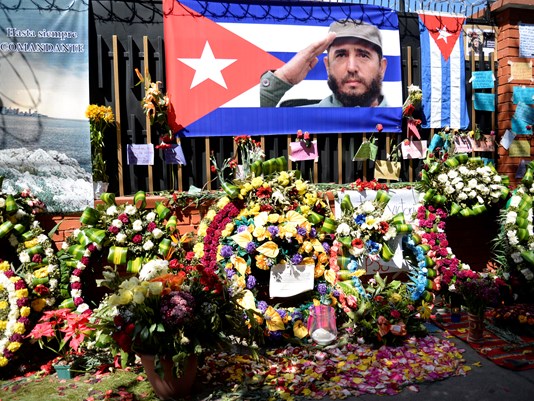Fidel Castro interred in rock, closing last chapter of historic life

SANTIAGO, Cuba : Fidel Castro’s ashes were placed in the niche of a boulder on Sunday, capping nine days of official mourning when hundreds of thousands of Cubans said farewell with a combination of tears, Castro-like defiance and choruses of “I am Fidel!”
President Raul Castro placed the wooden box containing his elder brother’s cremated remains in the 10 foot (3 metre) rounded stone at the Santa Ifigenia Cemetery, photos released by state media showed.
Castro died on Nov. 25 at age 90.
A dark plaque engraved with the word “Fidel” was then fixed over the niche. Dressed in his four star general military uniform, Raul Castro saluted the rock, which was flanked by two honor guards in white uniform.
Castro gave Cuba an outsized influence in world affairs. He was feted by Nelson Mandela for helping to end apartheid at a time when the West supported the racist system, but helped take the world to the brink of nuclear war during the Cuban missile crisis.
His monument sits a few steps from the mausoleum of independence hero Jose Marti, another towering figure of Cuban history who Castro long admired.
Castro had been out of power for a decade but never far from the center of public life. In his final years he wrote a periodic column on world and local matters and received foreign dignitaries at his home on the outskirts of Havana.
Forced to step down due to an intestinal ailment, he ceded power to his younger brother, at first provisionally in 2006, then definitively in 2008.
In keeping with his wishes, Castro’s image will not be immortalized with statues and public places will not be named after him, his brother said on Saturday.
His send off seemed reflective of a man who had a vast public career but could be intensely private about his health and personal life. Cubans still do not know the cause of his death, or where he was cremated.
After a three-day caravan in which hundreds of thousands of people lined streets and packed squares to bid him farewell, the last ceremony was not broadcast on Cuban media.
Instead, in Havana, military cannons unleashed a 21-gun salute that thundered across the capital city as the ceremony began hundreds of miles to the south east.
Castro’s memorial at the cemetery is a large, round stone placed close to, but dwarfed by, Marti’s mausoleum, according to a Reuters witness. The stone is a few steps from a monument to rebels who died fighting in Castro’s failed 1953 attack on the Moncada barracks in Santiago, the start of the revolution.
Seeing greatness in himself long before taking power, Castro created his own, enduring persona, and played the role with a flourish throughout his long public life.
He was at various times a triumphant revolutionary, an indefatigable speaker, and a military strategist. His larger-than-life character instilled Cuba with pride and national identity, while also generating acute hatred among his enemies.
It even came with its own wardrobe and props: olive green fatigues and military hat, boots and a beard, and, until he quit smoking in the 1980s, a long lancero cigar.
He ruled for 49 years, longer than any contemporary except for Queen Elizabeth of England, after overthrowing a U.S.-backed dictator in 1959. He went on to align Cuba with the Soviet Union and sustained a near-permanent confrontation with the United States, sending both doctors and soldiers overseas to burnish Cuba’s revolutionary character.
In recent years, Cuban doctors have been widely praised for their quick deployment in international health crises, including the Ebola outbreak and the aftermath of Haiti’s 2010 earthquake.
Even after ceding power to Raul, now 85, Fidel was a guiding light to leftists and anti-imperialists around world and a lightning rod for the barbs of his critics, who loathed him for confiscating private property, jailing opponents, and shutting down almost all dissent.
The impact of his long clash with the United States is still being felt. Cuban-Americans in Miami celebrated his death, and Washington maintains a trade embargo that Castro long used as the reason for Cuba’s economic troubles.
U.S. President Barack Obama changed course on U.S. policy toward Cuba in December 2014, agreeing on a prisoner exchange, declaring his intent to restore diplomatic ties and asking the U.S. Congress to end the embargo.
Fidel Castro gave begrudging approval to the detente brokered by his brother. He did not meet Obama during his historic visit to the island, instead penning a column that warned Cubans not to trust the president’s “honey-coated” words.
President-elect Donald Trump has threatened to reverse Obama’s rapprochement after he assumes the White House on Jan. 20 unless Cuba enacts internal changes, the kind of pressure both Castro brothers have vehemently rejected.
